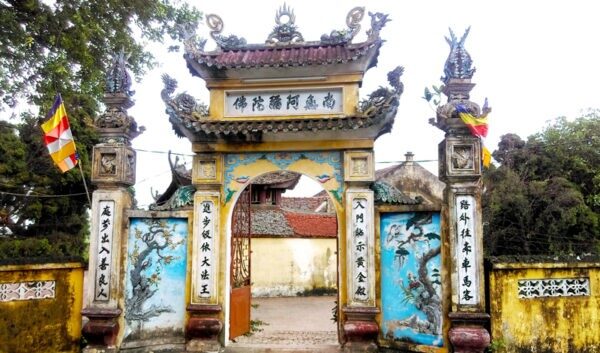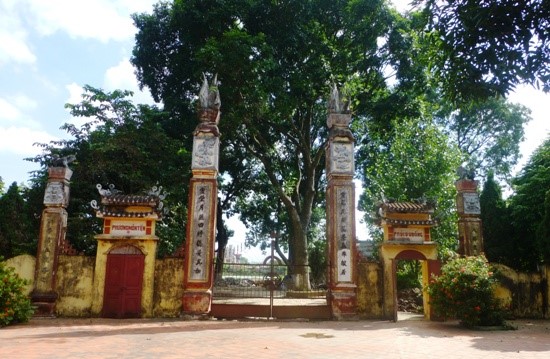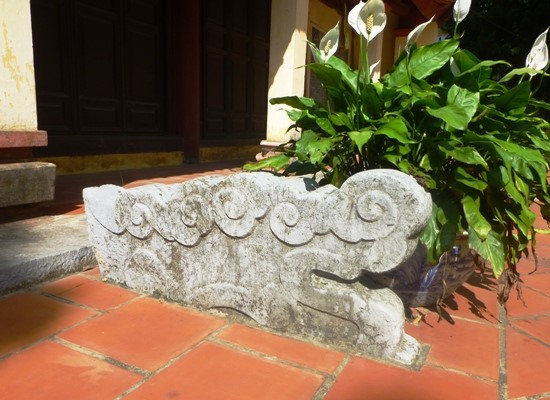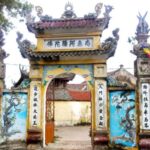
Phap Van Pagoda
Photo: Thuy Huong
If having the chance to come to Van Binh commune, Thuong Tin district, Phap Van Pagoda, a temple based on Four Dharmas beliefs is a never-to-miss place for you to study and see the beauty in architecture, landscape and immerse yourselve in the sacred atmosphere of Buddha.

Phap Van Pagoda is in Van Giap village., It followed the design of “Noi Cong Ngoai Quoc”, with a bell tower, front hall, and harem. From the gate of the pagoda, there is a large courtyard paved with Bat Trang tiles, on which there is a stele “Phap Van Tu Bi Ky” built in 1616. The stele printed about the pagoda repair, the rear streets and corridors were renovated by the monk Nguyen Tiem with the local people and mandarins, admirals, dukes, and their wives both inside and outside the region. Next to it, there are two stone dragons carved in the art style of the post-Le period. Next is the shrine. This architectural item is 21m long and 9m wide, above it hangs a bronze bell, so some people call it the steeple. The architecture was made in the style of two floors and eight roofs. The internal structure is in the form of 4 rows of wooden poles. From 16 pricipal pilar with “xa nach” (linking beam), there are 16 cross beams, they are also supports to form a corridor as high as the “co diem” part. They are 0.5m wide, paved to become walking boards. The bell tower hangs a 1.9m high, 1.05m in diameter bell. This is the largest bell in the region, casted in 1954.

The stone dragon in Phap Van pagoda
In the corners, there are dragon-shaped embossed blades. Through the main hall is the front hall consisting of 3 compartments. The front hall is connected to the upper hall by a system of “tubes” forming letter “H” structure for the entire temple. The upper hall consists of 3 compartments, on the central altar there is a large wooden box. The small altar has a roof in the style of a boat, surrounded by 3 covers lacquered and inlaid visors with the decorative theme of “van long hoi tu” (dragon on the cloud). Inside the altar, there is a 1.3m high Phap Van wooden statute. The statue sits on the throne, the outside is covered with brocade robes with a dignified, happy face. The statue (both face and body) has red brown painted according to the traditional method of Van Giap village. According to the elderly, the artist mixed the paint with the porpotion: Three parts of paint, one part of living resin, black alum, boiled and then painted over the statue in many layers according to the technique of skillful carpenter.
Phap Van Pagoda still preserves many precious relics: the book “Nam Thien nhi phap Legend of the True Sutra of Phung Luc” dated from the year of King Thanh Thai’s reign (1900), includes 8 silver leaves 13cm x 13cm x size. 22.5cm. The title of the book is inlaid with ten gold letters. The two covers are made of bronze embossed with a dragon shape; A pair of wooden peacocks painted with vermilion and gilded, 2.20m high, carved with legs, body, and beak. The feather pattern on the bird’s neck is stylized like a dragon’s beard. 2 dragon communal palanquins are delicately carved, painted with gold plated paint. These are relics of the 18th century.
Phap Van Pagoda Festival is held on the 8th day of the April (lunar year) with a palanquin procession that attracts a large number of tourists from other places. In 1991, Phap Van Pagoda was ranked as a national historical and cultural relic.
Thanh Binh

